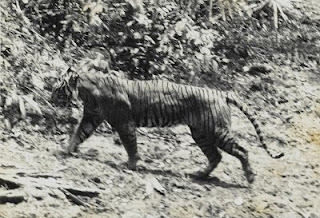Predator Becoming Prey!
Tiger as prey
Stereographic photograph (1903) of a captured man-eating tiger in the Calcutta zoo; the tiger had claimed 200 human victims.
Man-eating tigers
Main article: Tiger attack
Although humans are not regular prey for tigers, they have killed more people than any other cat, particularly in areas where population growth, logging, and farming have put pressure on tiger habitats. Most man-eating tigers are old and missing teeth, acquiring a taste for humans because of their inability to capture preferred prey.[128] Almost all tigers that are identified as man-eaters are quickly captured, shot, or poisoned. Unlike man-eating leopards, even established man-eating tigers will seldom enter human settlements, usually remaining at village outskirts.[129] Nevertheless, attacks in human villages do occur.[130] Man-eaters have been a particular problem in India and Bangladesh, especially in Kumaon, Garhwal and the Sundarbans mangrove swamps of Bengal, where some healthy tigers have been known to hunt humans. Because of rapid habitat loss due to climate change, tiger attacks have increased in the Sundarbans.[131]A female tiger Tatiana escaped from her enclosure in the San Francisco Zoo, killing one person and seriously injuring two more before being shot and killed by the police. The enclosure had walls that were lower than they were legally required to be, allowing the tiger to climb the wall and escape.
Traditional Asian medicine
Many people in China have a belief that various tiger parts have medicinal properties, including as pain killers and aphrodisiacs.There is no scientific evidence to support these beliefs. The use of tiger parts in pharmaceutical drugs in China is already banned, and the government has made some offenses in connection with tiger poaching punishable by death. Furthermore, all trade in tiger parts is illegal under the Convention on International Trade in Endangered Species of Wild Fauna and Flora and a domestic trade ban has been in place in China since 1993. Still, there are a number of tiger farms in the country specialising in breeding the cats for profit. It is estimated that between 5,000 and 10,000 captive-bred, semi-tame animals live in these farms today.ThankYou!
For Reading this post it really helps!
Please make sure to check the other posts as well!


Comments
Post a Comment